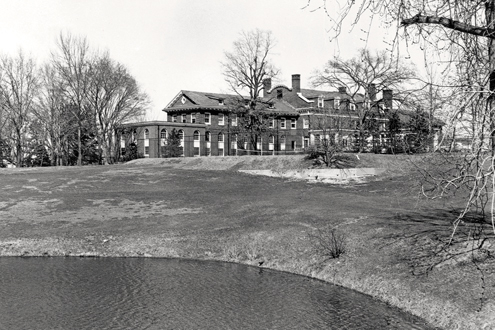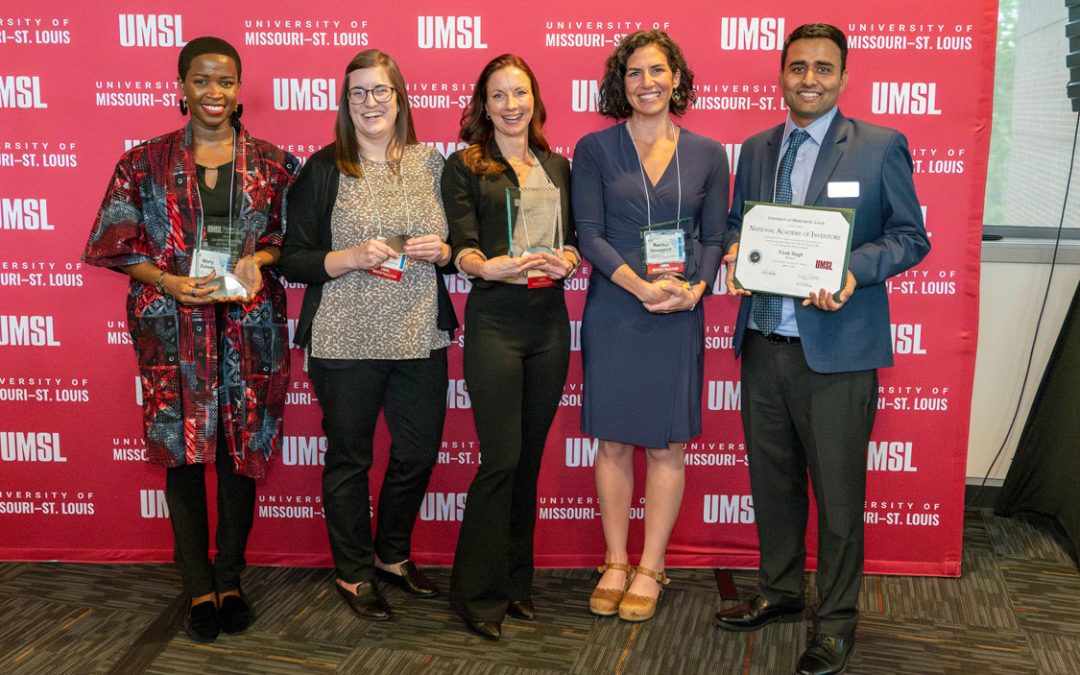
In 1960, the Normandy School District converted the clubhouse of the Bellerive Country Club to the University of Missouri–Normandy Residence Center, which housed freshman- and sophomore-level courses offered by the University of Missouri–Columbia. The clubhouse was the only building on campus when UMSL was founded in 1963. Later named the Administration Building, the 66-year-old structure was demolished in 1977. (Photo courtesy of University Archives.)
By the fall of 1959, the Normandy (Mo.) School District’s oft-discussed desire to develop a junior college appeared close to a reality. The district had acquired the needed land, but was now faced with an important question: How does a public school district establish an institution of higher education when elementary and secondary education are what it knows?
The Normandy Board of Education assembled a group of 28 men and women to find the answer. They became known as the Committee of 28, and they played a key role in converting a golf course into the University of Missouri–St. Louis.
Golf course for sale

(Photo by August Jennewein)
James Westbury (pictured left) was the director of special services for the Normandy School District when he was appointed to the Committee of 28. He says the district’s students were capable of succeeding in higher education, but the college enrollment rate for Normandy High School graduates remained low, mainly due to the cost of matriculation.
“They couldn’t afford Washington University, Saint Louis University or housing at the University of Missouri in Columbia,” he says.
The district flirted before with the idea of starting a junior college. Ward E. Barnes, then the Normandy School District superintendent, had publicly supported creating a state-funded university or college in the St. Louis area. Then in 1957, the Bellerive Country Club, a neighbor of the district’s administration offices, announced it intended to sell its 128-acre, 18-hole golf course. The asking price was $1.3 million.
The land drew interest from developers, but tough municipal zoning restrictions kept the property on the market. The club turned to the Normandy School District, offering the land for $600,000 if its members could continue to occupy Bellerive Country Club for up to three years while constructing new club grounds in west St. Louis County.
A $625,000 bond issue, supported by Barnes and the Normandy school board, went to ballot in September 1958. ($25,000 would go toward converting the country club into a college.)
“If the land would be sold for residential use, we’d have to build a new school to accommodate new students,” Westbury says. “So we were going to end up paying one way or the other. Our biggest selling point in the ballot issue campaign was to preserve this property for higher education.”
After gaining the necessary two-thirds approval votes, the district had its land.
In the fall of 1959, the club notified the district it would vacate the Bellerive property the following May. With new urgency to deal with the land, the school board formed the Committee of 28 in October 1959.
From country club to college
The Committee of 28 included a doctor, a lawyer, an artist, the president of the May Company, Normandy school board members, Normandy School District administrators and parishioners from Catholic churches in the district.
Westbury says he remembers the plan was to establish some form of higher education, likely in the shape of a junior college, which would benefit students from the district and across the St. Louis region. Committee members went on information-gathering trips to junior colleges in Hannibal, Mo., and throughout Illinois.
A subcommittee traveled to Columbia, Mo., in February 1960 to discuss how to achieve accreditation from the University of Missouri, which was responsible for accrediting all of the state’s junior colleges. During the conference, Elmer Ellis, president of the University of Missouri and a good friend of Ward Barnes, proposed that if the school district provide and maintain their new property, the university would provide an educational program.
“Normandy would cut the grass, keep the lights on and clean the building,” Westbury says. “We’d be the landlord. The courses offered would be right out of the Columbia catalogue. There was nothing second rate or diminished about this.”
The proposal meant instant accreditation for a two-year college, a quality education at an affordable price, minimal costs to taxpayers and the possibility of opening within months. The district would also have to ensure that at least 100 students enrolled at what would become known as the University of Missouri–Normandy Residence Center, a precursor to what is now UMSL. The committee’s new tasks were to promote the center to St. Louis-area high schools and prepare the Bellerive Country Club Building for classes in the fall.
Enrollment opened in May 1960. More than 100 students enrolled the first day, and the center reached its enrollment cap by the end of day three. In June, the district began renovating the building.
The center appeared to be a success after enrollment doubled the next year, but expansion was a problem. As Westbury points out, the district had no money to grow the program, nor did the university have any incentive to do so because it didn’t own the land.
The University of Missouri had a solution. In October 1961, the university proposed the start of a four-year university on the old country club grounds if the school district turned over the land to the university.
The Normandy school board agreed to sell the land to the University of Missouri for valuable considerations and a token payment of $60,000.
“There were more than a few people who challenged the wisdom of that,” Westbury says.
The Missouri Supreme Court ultimately voted down the sale 4-3. The district would have to follow the rules for selling public property, which involved accepting the highest bid. The Missouri General Assembly later intervened (see story on House Bill 153), allowing the Normandy School District to sell the land to the University of Missouri.
UMSL begins, the Committee of 28 ends
With the property transferred from the district to the university and UMSL’s opening in 1963, the Committee of 28 concluded its successful mission. Westbury was named superintendent of the Normandy School District in 1977, a role he continued until he retired in 1987. Two of his children went on to earn a total of three degrees at UMSL.

(Photo courtesy of State Historical Society of Missouri)
“It was a matter of timing and availability,” he says, reflecting on the establishment of UMSL. “It was a unique and very unusual set of circumstances that caused it all to happen. The guiding light behind it all was Ward Barnes. I can’t emphasize that enough.”
Barnes (pictured right) spoke about the university’s beginnings in a 1972 interview archived at UMSL.
“This is a success story that probably has not been equaled by many places in this country,” he says. “There has developed here an institution that will make contributions to this metropolitan area and to the state for many, many years to come.”
Barnes died in 1993. Westbury says he was a visionary but doubts if Barnes or anyone from the Committee of 28 could have envisioned what UMSL has become today.
Committee of 28 members
A total of 29 individuals served on the Committee of 28, but only 28 served at any given time. James Westbury is the last surviving member of the committee.
William F. Allison
Ward E. Barnes
Daniel F. Bauer
Roy W. Bergmann
Herman C. Bleckschmidt
Morris Blitz
Fred O. Coble Jr.
Roland L. Diehl
Mildred C. Erhart
Edward F. Ford Jr.
Irma G. Hill
Newell J. Holbrook
Gerald A. Koetting
Roland H. Kolman
Raymond N. Leach
C.R. McAdam
A.H. McKain Jr.
Fay McKinney
Edward Monaco
C.E. Potter
Geoffrey Probert
V.J. Rosengreen
Raymond M. Schmidt
Fred R. Small
Jerry W. Turner
Ben H. Walter
Harry T. Weeks
James Westbury
Ballard A. Yates
This story was originally published in the spring 2013 issue of UMSL Magazine.














